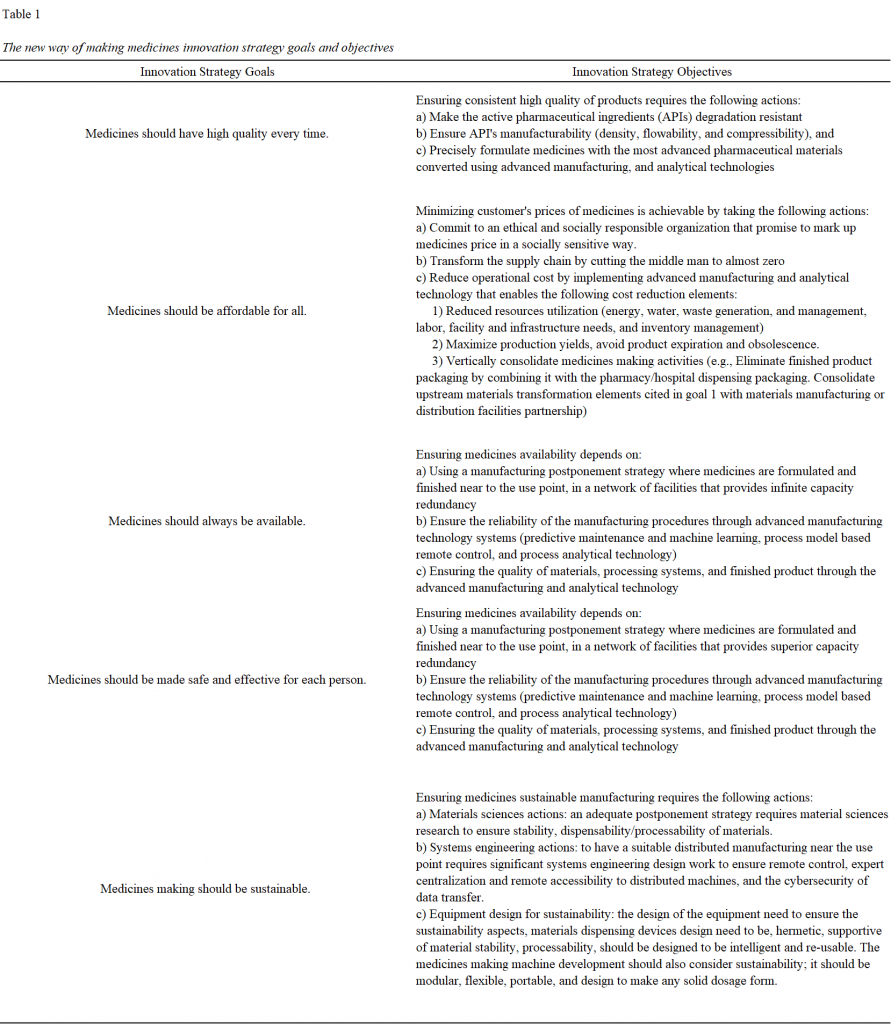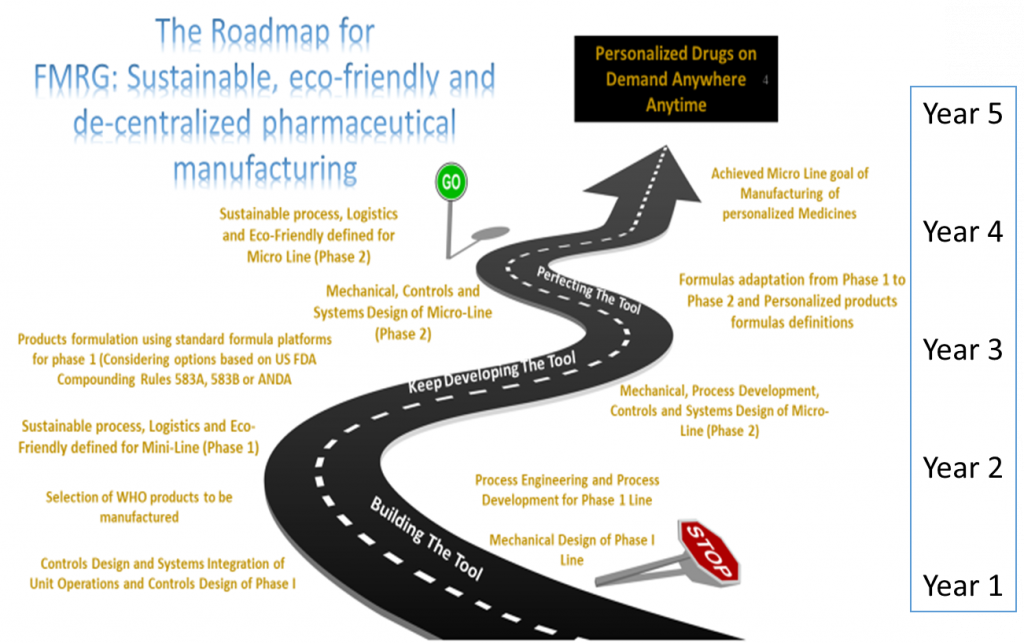Introduction
The manufacturing and supply of generic drugs need a transformation for its sustainability, quality, manufacturing modernization, supply reliability, and affordability. The best way to reach this transformation is by using pharmaceutical technologies advancement and innovation. This innovation strategy provides the basis of this transformation of generic medicines tailored to any generic manufacturer.
The generic market; a typical company.
What technology-driven opportunities lie for a generic manufacturer? Are they considering the supply reliability, quality, manufacturing modernization, and sustainability needs of generic medicines?
Typically, generic companies do not entertain much effort in introducing technology. A traditional generic company SWOT analysis revealed some concerns with respect to business model threats. The main threat of a generic manufacturer business model consists of the risk brought by the medicines affordable act, or the health care reform act (US Senate, 2018). This threat reveals the need from generic manufacturers to control cost to ensure competitive prices and the allowance for Medicare rebates mandated by the US government. Besides the medicines affordability congress initiatives other business liabilities include those related to the company’s manufacturing practices and cGMP compliance issues (Saumya & Aakash, 2019, Food & Drug Administration, 2018, and West, 2018). Nevertheless, with all these business treats of generic companies, are these companies a good target for an innovation strategy like the one described in this article?
Innovation project design.
The innovation strategy described in this article is an elongation of the innovation process design previously posted on my blog (Sánchez-Rolón, 2020). In summary, the innovation consists of changing dramatically the pharmaceutical process of generic tablets and capsules in a way that permits manufacturing in a distributed form. The latest progress in pharmaceutical manufacturing technology based on continuous manufacturing and spectrophotometric analytical technologies enables this transformation. These technologies permit the manufacturing of drug products near to the point of dispensing, at the pharmacies and hospitals, which allows for a dramatic reduction of the manufacturing/packaging operations, analytical, and supply chain costs.
The hypothesis of this innovation strategy is that the economies of scale which traditionally enforces the use of complex supply chains and centralized manufacturing may have a higher cost than a technology-based regionally distributed manufacturing where the competencies of reduced operational cost, shrink supply chain, inventories controls, and quality-related cost can result in a better economical makeup. In addition, this new way of making medicines allows for the opportunity for the development of safer and better performing dosing regimes which opens an innovation path for new products that require this type of technology at an affordable cost.
The innovation strategy for a new way of making medicines.
Under economic favorable or unfavorable conditions, innovation strategies prove to be a source of differentiation, and proficiency of companies on their competitive advantage (Cooper & Edgett, 2010, Bowonder, Dambal, Kumar, & Shirodkar, 2010, and Bodley-Scott, 2011). Innovation strategy preparation and implementation require a deep evaluation process full of market evaluation insight, evaluation of the business environment, and abundant skillset portfolios (Cooper & Edgett, 2010, and Bowonder et al., 2010). Creating a new way of making medicines, certainly requires a finetuned innovation strategy. This article proposes an innovation strategy for this goal based mainly on Cooper and Edgett (2010) innovation strategy framework.
Why humanity needs a new way of making medicines? Sánchez-Rolón (2020) provided a definition of why humanity needs a new way of making medicines. In short, there are five reasons why this project makes a wonderful contribution to humanity.
Humanity needs a new way of making medicines because:
- Medicines should be manufacture with high quality every time
- Medicines should be affordable for all.
- Medicines should always be available.
- Medicines should be made safe and effective for each person.
- Medicines making should be sustainable
Goals and objectives. An innovation strategy starts with a well-defined set of goals, which are the general intentions of the business innovation program. The objectives on the other hand are the specific, narrowly defined, and concrete actions needed to achieve those goals (Cooper & Edgett, 2010). Table 1 summarizes this project’s goals and objectives. The five reasons why we need a new way of making medicines are the goals of this innovation project. Table 1 provides specific objectives for each goal.

Strategic arenas and areas of focus: The goals and their specific objectives defines three main arenas of action and definition of attack strategies. These arenas are:
- The supply chain transformation process.
Although the action of creating a distributed manufacturing that is near to the point of use appears as logic and simple solution to the quality, affordability, availability, safety/efficacy, and sustainability of medicines making, there is a huge challenge on defining the new supply chain design and how the materials will be made available at the right configuration, amounts and fulfilling all safety and industrial hygiene requirements. This is an important area of focus to make this project a successful one.
- The technology advances on materials sciences.
The current level of knowledge in materials sciences for pharmaceutical structured organic particulate systems had made significant advances in the latest years, specifically on the understanding of material properties effect on solid dosage formulations and processing (Oka, Sahay, Meng & Muzzio, 2017, Grigorov, Glasser & Muzzio, 2016, Grigorov, Glasser & Muzzio, 2013, Muzzio, Glasser & Grigorov, 2018, and Grigorov, Muzzio & Glasser, 2019). This knowledge enables a different way of using materials properties to fulfill the goals of this project in the stabilization and processability of materials to obtain the desired effect on product quality and consistency of manufacturing.
- The technology advances on the machine that makes medicines that do not exist.
This project requires a significant advance on medicines making to support the new way of making them at the user’s specific needs. Personalized medicines are those medicines that require specific dosing regimes that are distinct from the regular fixed-dose typically used in pharmaceutical prescriptions (Archer, 2019). Making medicines this way requires a completely different makeup of equipment, systems, and logistics that needs to be designed and built.
- The technology enabling sustainability of the process
Finally, the technological changes proposed for this innovation strategy will enable the sustainability of pharmaceutical manufacturing from the societal, economic, and environmental perspectives.
Attack Strategy. This innovation attack strategy starts with a leadership positioning, specifically for the development of the micro-manufacturing machine. The cost differentiation will come from the transformation of the supply chain and the economies related to avoiding markup of the multiple touchpoints of the supply chain and the operational cost reductions. This project has a clearly global benefit scope, nevertheless, the US domestic market represents the largest opportunity. The proposal for the technology development includes the use of an open innovation approach with a University consortia lead by UPR Mayaguez, and include the UPR School of Pharmacy and Rutgers University.
Deployment strategy. This strategy deployment will require a significant investment inxxx a multi-year, multi-functional project management approach. The project deployment can be defined in four major areas.
- The technology development stage, which includes the mechanical and systems integration of the micro-manufacturing robotic machine that will manufacture products at the pharmacy setting.
- The formulation and materials science transformation, which includes the aspect related to the development of the materials dispensing technology that will enable the manufacturing at the pharmacy setting.
- The supply chain transformation modeling which requires a significant effort designing the new elements of the supply chain that requires the manufacturing at the pharmacy setting.
- Finally, the evaluation and approval process by the health authorities in the countries where the technology will operate.
Figure 1 provides a graphical representation of this innovation implementation plan. This technology implementation should take approximately 5 years at the end of which a working prototype will be shared with customers for further refinement before implementation.

Figure 1. Strategic roadmap for the new way of making medicines
Conclusion
The modernization of generic manufacturing is an imperative long-awaited by the US FDA (Gottlieb & Woodcock, 2019). This public health imperative requires the attention of pharmaceutical companies, particularly generics manufacturers. Medicines affordability, availability, quality, safety, and efficacy as well as manufacturing sustainability are achievable through technology applications that are at the reach of these companies. This innovation shall provide any generics manufacturer an edge into the realization of these goals and the creation of a new way of making medicines.
References
Archer, R. (2015). Precision medicine; imprecise manufacturing and supply. The Medicine Maker. Retrieved from https://themedicinemaker.com/manufacture/precision-medicine-imprecise-manufacturing-and-supply
Bodley-Scott, S. (2011). Linking innovation to strategy. Training Journal, , 64-66. Retrieved from http://library.capella.edu/login?qurl=https%3A%2F%2Fsearch.proquest.com%2F docview%2F855805008%3Facc
Bowonder, B., Dambal, A., Kumar, S., & Shirodkar, A. (2010). Innovation strategies for creating competitive advantage. Research Technology Management, 53(3), 19-32. Retrieved from http://library.capella.edu/login?qurl=https%3A%2F%2Fsearch.proquest.com%2Fdocview%2F506410190%3Fa
Cooper, R. G., & Edgett, S. J. (2010). Developing a product innovation and technology strategy for your business. Research Technology Management, 53(3), 33-40. Retrieved from http://library.capella.edu/login?qurl=https%3A%2F%2Fsearch.proquest.com%2Fdocview%2F506430810%3Faccou
Food & Drug Administration (2018, Nov 9th). Warning letter, Mylan Pharmaceuticals, Inc. U.S. Food and Drug Administration. Retrieved from https://www.fda.gov/inspections-compliance-enforcement-and-criminal-investigations/warning-letters/mylan-pharmaceuticals-inc-557903-11092018
Gottlieb, S. and Woodcock, J. (2019). FDA is advancing new efforts to address drug shortages. FDA web page blog, retrieved from https://www.fda.gov/NewsEvents/Newsroom/ FDAVoices/ucm626108.htm
Grigorov, P. I.; Glasser, B. J.; Muzzio, F. J. (2016). Improving dissolution kinetics of pharmaceuticals by fluidized bed impregnation of active pharmaceutical ingredients. AIChE Journal, 62 (12), 4201-4214.
Grigorov, P. I.; Glasser, B. J.; Muzzio, F. J. (2013). Formulation and manufacture of pharmaceuticals by fluidized-bed impregnation of active pharmaceutical ingredients onto porous carriers. AIChE Journal, 59 (12), 4538-4552.
Grigorov, P. I.; Muzzio, F. J.; Glasser, B. J. (2019). Modeling fluidized bed impregnation of active pharmaceutical ingredients onto porous excipients. Chemical Engineering Science, 202, 36-54.
US Senate (2018). Affordable medications act. US Senate bill S.3411. Retrieved from https://www.congress.gov/bill/115th-congress/senate-bill/3411/text?format=txt
Muzzio, F. J.; Glasser, B. J.; Grigorov, P. I. (2018). Formulation and manufacture of pharmaceuticals by impregnation onto porous carriers. U.S. patent 10,004,682B2, 2018.
Oka, S.; Sahay, A.; Meng, W.; Muzzio, F. (2017). Diminished segregation in continuous powder mixing. Powder Technol 309, 79-88.
Saumya, J. and Aakash, B. (2019). Mylan gives no clear view on strategic options, shares plunge 17 percent. Reuters. Retrieved from https://www.reuters.com/article/us-mylan-nl-results/mylan-gives-no-clear-view-on-strategic-options-shares-plunge-17-percent-idUSKCN1SD1H0
Sánchez-Rolón, E.J. (2020). An innovation process design for a new way of making medicines. Capella University Course BMGT 8136, Unit 7 Assignment. Retrieved from https://itradeandinvest.com/2020/06/16/an-innovation-process-design-for-a-new-way-of-making-medicines/
West, T. (2018). Concern over Concerta. The Being Well Center. Retrieved from https://beingwellcenter.wordpress.com/2018/03/23/concern-over-concerta/
